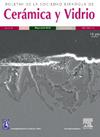甲硝唑和甲硝唑-臭氧复合多层支架的抗菌性能研究
IF 2.7
4区 材料科学
Q1 MATERIALS SCIENCE, CERAMICS
Boletin de la Sociedad Espanola de Ceramica y Vidrio
Pub Date : 2025-05-01
DOI:10.1016/j.bsecv.2025.03.002
引用次数: 0
摘要
本研究比较了两种不同的支架(硅酸二钙- Ca2SiO4 -核心覆盖有掺杂锂和锶的Ca2P6O17组成的玻璃)单独负载甲硝唑和甲硝唑结合臭氧。采用配合物甲硝唑-2-羟丙基-β-环糊精(HP-β-CDs)提高甲硝唑的溶解度和可用性。使用的甲硝唑浓度为40.8 mg/mL (58.4 mM),摩尔比为1:1,在不同的支架中加入1.5 mL臭氧油。圆盘扩散法对革兰氏阳性菌金黄色葡萄球菌和革兰氏阴性菌大肠杆菌均有抑菌作用,但无统计学意义(p >;单用甲硝唑和与臭氧联用甲硝唑产生的光晕抑制作用(0.05)。这项研究预计将对骨坏死患者的生活质量产生强烈的社会影响,因为这些纳米结构锚定在具有多孔3d核的结构上,可以通过细胞粘附、血管化和营养供应促进骨再生。本文章由计算机程序翻译,如有差异,请以英文原文为准。
Antimicrobial properties of different multilayered scaffolds complexed with metronidazole and metronidazole-ozone
This study compares two different scaffolds (dicalcium silicate – Ca2SiO4 – core covered with a glass of composition Ca2P6O17 doped with lithium and with strontium) loaded with metronidazole alone and with metronidazole combined with ozone. Complexes metronidazole-2-hydroxypropyl-β-cyclodextrins (HP-β-CDs) were used to increase the solubility and availability of metronidazole. The concentration of metronidazole used was 40.8 mg/mL (58.4 mM), with a molar ratio of 1:1 and 1.5 mL of ozone oil were added to the different scaffolds. The disk diffusion method against the Gram-positive bacterium Staphylococcus aureus and the Gram-negative bacterium Escherichia coli showed microbial inhibition but not statistically significant (p > 0.05) halo inhibition produced by metronidazole alone and that produced by metronidazole combined with ozone.
This research is expected to have strong social impact directly affecting the quality of life of those affected by osteonecrosis as these nanostructures anchored to structures with a porous 3D-core could facilitate bone regeneration promoted by cell adhesion, vascularization and nutrients supply.
求助全文
通过发布文献求助,成功后即可免费获取论文全文。
去求助
来源期刊

Boletin de la Sociedad Espanola de Ceramica y Vidrio
工程技术-材料科学:硅酸盐
CiteScore
5.50
自引率
2.90%
发文量
72
审稿时长
103 days
期刊介绍:
The Journal of the Spanish Ceramic and Glass Society publishes scientific articles and communications describing original research and reviews relating to ceramic materials and glasses. The main interests are on novel generic science and technology establishing the relationships between synthesis, processing microstructure and properties of materials. Papers may deal with ceramics and glasses included in any of the conventional categories: structural, functional, traditional, composites and cultural heritage. The main objective of the Journal of the Spanish Ceramic and Glass Society is to sustain a high standard research quality by means of appropriate reviewing procedures.
 求助内容:
求助内容: 应助结果提醒方式:
应助结果提醒方式:


